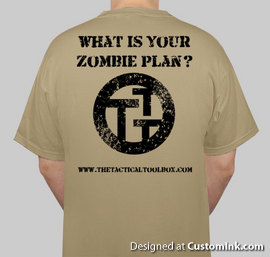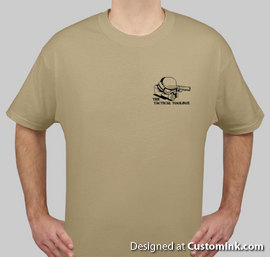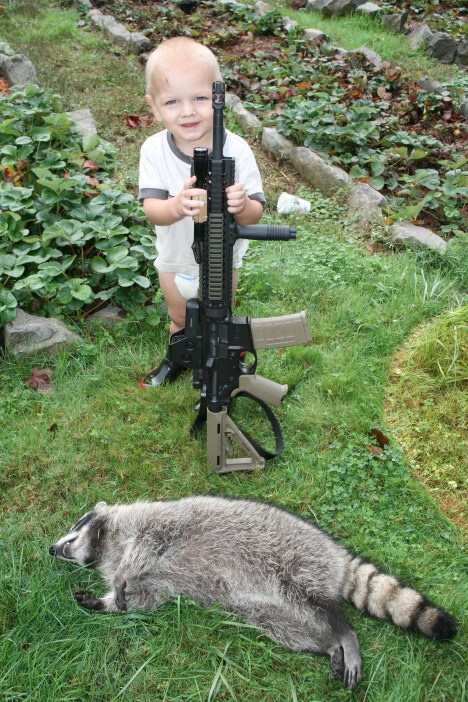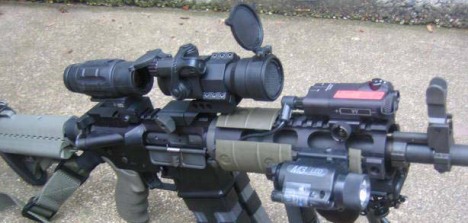Issue #2, November 14, 2009
The Tactical Toolbox Newsletter provides product reviews, training thoughts, political thoughts and anecdotal tidbits about shooting, self-defense and current Toolbox community events.
In this issue:
***More on tactical optics—magnifier options
***Black Friday Special
***Evaluating concealed carry options–part one
Tactical Optics – magnifiers revisited:
Above shown the LaRue Tactical mounts and Aimpoint Comp M2 w/ Aimpoint magnifier.
After some backlash over the stuff I said about magnifier options like the EoTech flip to the side magnifier and the Aimpoint setup, I will have to re-examine why I said the things I did. A partial quote follows of some of the issues one alert reader had:
Ok, about the optics… I think you should give more of your “mission” to validate your opinion or to lend it more weight. I just got the impression it was a “everybody should do it this way” type of argument. Also. Have you ever used an aimpoint magnifier? Some of the things you comment on, I wonder if you’ve really used. No offense man, just saying how it comes across.
Also, it seems a bit like you have valid points, but for those 5% of scenarios. I would rather plan for the 95% of scenarios than the 5% personally. Maybe I’ll read it again and then comment on it for your review.
The alert reader has several points:
#1 it seemed I didn’t properly describe my mission.
My response:
If it wasn’t clear enough, the mission parameters I was reviewing for were general civilian defensive rifle usage. This means taking one rifle to engage potential threats from zero to 250 yards. But I did caveat for the reader’s individual needs, such as, “If you only are preparing to engage an enemy at 50 yards and under and rarely over 75 yards, a red dot optic might work best.”
#2 the reader got the impression I was making an “everyone should do it this way” argument
My response:
I thought I was clear enough in the article that I was contrasting the optical equipment with the mission. If close range only, the red dot would work well. It was my opinion/conclusion that the magnifiers were not worth the money or weight/stowage trouble. Perhaps I was too harsh?
#3 have I ever used an Aimpoint magnifier?
My response:
I do not have an Aimpoint. I opted for the Eotech because of the ruggedness of the system due to its holographic nature. If any little piece of the window is left, even if it is struck by a bullet (now just think where the bullet might go after it passes through the window) or flying debris, the reticle will be visible in the left-over window shard. I also liked the overall lower profile. It is not that the Aimpoint is an inferior piece of equipment. It is just that I liked the aforementioned features better than what the Aimpoint had to offer.
On to the more relevant answer, I have tested my own Eotech by putting a ten power binocular optic behind it. The results were impressive (although trying to hold a binoc up to one’s eye and steady the rifle is a really fun thing to do). However the results, they did not convince me to go ahead on a $600-$800 optic that only had four power magnification. My experience with shooting the AR with an ACOG left me with desire for even more magnification and with that, variable magnification (2x to 7x). This is not, at this time, available in flip to the side magnifiers.
#4 it seems I am preparing for 5% of scenarios:
My response:
Yes, I am preparing for 5% of scenarios. It is the 0.5% badguy that makes your day really suck. I carry a gun every day for that < 0.01% of days. Considering that a civilian scenario involving rifles is likely to unfold slower than one involving pistols, it is reasonable to believe a threat will take cover and be attacking from it. It is also reasonable to assume one attacking from cover would present a very small target, possibly half a head. My reasoning concerns weighing the need for that scope in the < 5% of scenarios versus the utility loss in using that high powered capable optic at close ranges. I personally find it not interfering in the utility enough to outweigh its utility. This personal discovery was echoed during training in that a novice rifle and scope user was trained to shoot at close ranges and didn’t seem to suffer from being required to use 2.5x optics. A little practice and he was fine.
Conclusions:
My main concerns about the flip to the side are its cumbersomeness, stowage issues, and cost versus its overall utility. I shall discuss each concern below.
Concerning cumbersomeness, I refer specifically to the fact that when flipped to the side, the optic is sticking out from the rifle and therefore subject to two things: lack of streamlining such that it might catch on team members or environmental obstacles–or it might interfere with ambidextrous use of the rifle. I say “might” because I have not personally used these optics. I only know general principles and designed certain features of my own tactical sling based on my experience in deep brush. It grabs everything that has a hole in it or sticks out. This unit sticks out when flipped to the side. When the unit sticks to one side, that makes me wonder about ambidextrous use of the rifle. Maybe our alert reader could share with us his experience in this area.
Second I would refer to stowage of the optical unit (when removed from the rifle). This is not always a problem, but in the civilian sense, he isn’t typically suited up for battle on a schedule. The battle comes to him. If the optic is needed but is stowed, he has to retrieve and attach it. Second, when not in use, he has to have a place to stow it separate from the rifle. This takes planning and more gear. Grabbing just the rifle, one extra mag, and going is not as much the option. Discussing the virtues of detach only versus flip to the side is outside the scope of this article.
When considering the overall cost of an Aimpoint or Eotech plus the $600 optic, the total cost is likely in excess of $1k. This opens up a wide range of possibilities for the shooter who is trying to maximize the range spread of his rifle. If he is not trying to maximize his range spread and his utilization of the optic is controlled and mission specific, his motivations obviously vary. So, if he is required to, say, clear a building and then sit on its roof covering a battlefield in which ranges wouldn’t exceed 150 yards because he was backed up by a real precision rifle, the flip to the side magnifier is a good choice. For more general usage a consumer might be much better suited with a variable riflescope (with lighted reticle) as I concluded in newsletter #1.
Concerning utility, my biggest issues are from experience in the 100 to 300 yard range. I found that an 3x ACOG was ill suited to the task of what I felt was true confident precision at 100 yards and beyond. Maybe I was incorrect, but that was my experience. It might have also been the reticle because the 100-300 yard ranges are obscured by the chevron. I still felt I couldn’t see well enough with the optic to define my target too well at 300. My concern with this was that I was shooting at a fluorescent pink painted 5”x10” plate at 300 yards and I could hardly see it any better with the 3x optic than I could with the naked eye. I am assuming my threats will not be painted fluorescent pink and will be at least as small if they are taking cover. So, with the magnifiers maxing out at 4x not giving enough magnification/definition for targets in the 100-300 yard range, I would instead opt for a regular rifle scope having a higher high-end magnification. Here, the utility of the scope is probably much better than the magnifier (given we’ve spent about the same money on the scope as the magnification combo).
Again, the downsides of the scope option are lack of co-witnessing BUIS (back up iron sights). During a fight, a damaged optic is much more easily ignored with the magnifier option. Removing the scope, even with a quick detach system, would take a hair longer than the FTS magnifiers would to just flip them to the side. To me, these are not enough reason to go with the magnifiers in general use over the lighted reticle scope given its gain in precision usage of the AR platform.
Your mileage might vary. But hey, if the magnifiers light your fire, let me order you one today.
Black Friday Special!
The Friday after Thanksgiving will be a special day. The sale day will extend through the end of Saturday. I am not sure if the prices are ever going to get lower on the items I’m putting up on special. On some items, I won’t be making a dime.
Something special about Friday and Saturday will be free gourmet coffee and those special biscotti for which my classes are getting famous. Drop by and get some! You won’t regret it.
Rifles:
FNH Patrol Bolt Rifle, all black, detachable box magazine, .308 Win, 24 inch heavy barrel. Comes with a 10 power Bushnell Elite 3200 mil-dot scope with quality steel tactical rings, mounted.
This rifle is a quality mid-level precision rifle system. Topped with a solid scope like the Bushnell Elite 3200, it should get good precision performance out to 1,000 yards. Scope is not in stock and must be ordered.
MSRP without scope: $1,208
Sale with scope: $1,208
Sale without scope: $875
Next Generation Arms Patriot Model M4 Carbine Clone: 16 inch M4 profile barrel, PWS muzzle brake/flash hider, A4 flat top with stand alone detachable A2 rear sight, six position collapsible stock, M4 handguards, A2 grip, standard military spec two stage trigger.
This is the last of the inexpensive Next Generation Arms rifles. While they are no frills, they are internally just as solid as the current Next Generation $3,600 top of the line models. This rifle is a far superior alternative to the Colt LE series rifles. This price and value cannot be beat anywhere and the two Patriots I have are likely to be the last ones I will get in.
MSRP: $1,600
Sale price: $1,225
Next Generation Arms Minuteman w/ Noveske 14.5” double chrome lined: the same features as the above Patriot plus the exclusive enidine system tuned just for Next Generation Arms, and a top of the line Noveske 14.5” double chrome lined machinegun barrel with permanently attached suppressor.
This barrel upgrade is capable of 3/4 MOA and is far superior to regular mil-spec or other barrels due to its ridiculously long life. 14 ½ inches means that it is as short and light as you can get without paying a $200 NFA tax for a short barreled rifle. Again, these Minutemen are last year’s models and won’t be coming back. This is a one of a kind due to the custom barrel.
MSRP: $2,250
Sale Price: $1,600
Bushmaster A3 heavy profile fluted carbine: Regular Bushmaster carbine but with a heavy profile barrel fluted for accuracy. This model has the detachable carry handle, collapsible stock, all the standard features in addition to the fluted barrel.
MSRP: $1,299
Sale Price: $975
Also available:
Polish Tantal AK74, 5.45×39 $650 two in stock
Next Generation Arms JC382 Patrol, dark earth $2152 MSRP
Next Generation Arms JC382 Advanced Tactical, tactical grey $2339 MSRP
Pistols:
All pistols in stock will be $20-$100 off marked price. For women, all pistols come with a free hour of safety instruction.
Magazines:
Rifle:
All AR15 rifle mags in stock will be on special Black Friday Weekend Only:
Cproducts 30rd Aluminum, Magpul follower $9 ea.
Lancer L5 30rd $16 ea. @ Cost!
Magpul window gen 1, black and foliage green $15 ea.
Magpul gen 1 foliage green $14 ea.
Magpul new gen window, green, black, dark earth $18 ea.
Magpul new gen 20rd $16 ea.
Pistol mags:
All pistol mags will be $2-$5 off. Check in for availability and pricing. We have tons of XD and hard to find Steyr mags as well as some Kel Tec. Glock 22 and 23 mags available. Some CZ and HK mags. Many misc. and hard to find magazines in stock, too.
Evaluating Concealed Carry Options, Part One, Threshold Issues:
This is going to be a multi-part series concerning the issues surrounding concealed carry methods.
Just one step into the section of a gun store that contains holsters or onto the internet home page of a holster manufacturer is enough to apprise the shopper there are myriad options available for concealed carry of a handgun. Online, whole sections are dedicated to confusing acronyms and holster names such as IWB, pancake, paddle, and fanny pack. To a new shooter or someone uninitiated to these things, a confusing array of delicious boating apparel is not what he or she was expecting to see. In the actual store, everything might look so foreign to the shopper that he or she can’t figure out how such contraptions might be used to secure a handgun or to what part of the body it might be attached. The reason for this article is to give an overview of some methods of carry and their advantages and disadvantages.
The purpose for all those holster designs is that people come in all different shapes and sizes and their carry needs vary almost as greatly. A method that works for a large individual might not work for a slighter one. Conversely, we fat folk cannot always utilize methods used successfully (or more pointedly less painfully) by the slighter folk. The differences in people run across the gender line, too in that women are not proportioned the same as men. Carry options for men don’t always work for women. Exacerbating this overall problem is the carry needs issue. Some feel the need for larger handguns; others live in very hot climates.
Because the nature of an object is that it is separate from its owner, some manner of stowing it on the person necessitates a system. This means a gun is not natural to keep with you. You weren’t built with holsters or pockets on your body. Everything is a compromise. This article contrasts the compromises.
 Pictures courtesy of Galco.
Pictures courtesy of Galco.
Threshold Issues:
When looking to conceal your handgun, several questions need to be answered first:
#1 Overall, how big of a handgun is sufficient to make me comfortable in defensive use?
#2 In what type of climate is it going to be concealed?
#3 What concessions am I willing to make concerning clothing options?
#4 Comfort vs. concealed effectively?
#5 Am I willing to deal with the issues arising from my chosen method of carry?
1. Overall, how big of a handgun is sufficient to make me comfortable in defensive use?
I am first assuming the reader has gone through the appropriate hoops to obtain the proper permission to carry a handgun concealed in their jurisdiction and otherwise follows all relevant laws. Either that or a reader is contemplating concealed carry and wants more information on the subject and is thus, reading this article.
This issue is a large one and bears on the method of carry as much as almost anything else. The larger the handgun, the fewer places to hid it effectively. Factors a prospective gun packer (PGP) will have to contrast will include the caliber selection (in my book 9mm Lugar is the minimum), frame size and barrel length, shootability/utility, shooting comfort, and ammunition capacity versus the practicality of actually carrying it. The first rule of gunfighting is to have a gun. The second rule might be to carry a big enough gun. It has to be powerful enough and accurate enough to be effective. But too much power usually means size or controllability issues. This means too much recoil to control the gun or the gun is just too darned large to pack around.
Mainly what I am arguing against are guns just too small to do any good as a primary defensive handgun. A good question to ask yourself is, “If I knew there was going to be trouble and had to pick a handgun, what would it be?” If the answer to this is within reason, then we can start looking for a concealment option. If the concealment options aren’t favorable for this, a different choice would be best. If my first choice is too big, I usually opt for a shorter barrel and/or grip length, while retaining the same action type (revolver or pistol) and caliber as the original (as long as the original wasn’t A. a Desert Eagle .50 AE, or B. a magnum revolver of .41 cal or larger). This cut-down usually makes the concealed carry option more palatable.
2. In what type of climate is it going to be concealed?
The climate makes a large difference on what is carried where. As a general rule, less clothing necessitated by warmer climes is detrimental to concealment. Some handguns combined with some body types make for a nearly impossible combination for concealment in hot weather. When I lived in Oregon, it almost never got so hot I sweated too badly. When I lived in Kentucky, it was so hot and humid in the summer, I sweated so badly I dared not carry my beloved Kimber 1911 .45s. They would most assuredly have rusted to uselessness. I instead carried an HK as it didn’t have rust issues (and it wasn’t nearly as beloved). However, because the HK didn’t conceal well under a t-shirt, I had to opt for a fanny pack method.
3. What concessions am I willing to make concerning clothing options?
A person who does not carry a pistol concealed dresses according to style or likes and dislikes based on factors that didn’t involve carrying a pistol under his/her clothing. When starting to carry concealed, you may have to adjust your wardrobe. The latest fashions were likely not designed with carrying a pistol in mind. Now, some of my readers might have already been perusing the 5.11 tactical store. Some might think that fashion will have to be tossed out the window entirely and we’ll all be walking around in khaki colored fishing vests and modified BDU’s looking like out of place fly fishermen. This is just not so. There are a lot of options and holsters designed with the suit wearing office worker in mind as well as the knit polo shirt wearing blue collar worker.
However, the fact remains, your concealed carry method may be modified by how far you’re willing to change your fashions. Is it worth it to look a little fatter in order to carry your pistol with you?
4. Comfort vs. concealed effectively?

Sometimes it is somewhat uncomfortable to be carrying your favorite blaster in certain spots. The most complained about concealment options are, in order, appendix (AIWB) and inside-the-waistband (IWB). Both methods place the handgun inside a holster (hopefully) which is located inside the pants of the PGP. Appendix carry has the gun up front usually just to the right of the belt buckle. IWB might be in one of several different locations, which include behind the right hip, in front of the left hip, or just right in the middle of the back. Normally people tighten their belts to hold their pants secure. There is usually not a lot of extra room in there. As typical Americans, maybe there is a little less extra room in there. This usually translates into pain and suffering. What might be the conundrum? The conundrum is that both the appendix and IWB carry methods are fast and more secure than others. A lot of the time, the real question for men is, how much pain is too much? For a lot of women, their bodies are not conducive to right hip IWB and appendix carry doesn’t fit their wardrobes.
Other issues concerning comfort are the weight of the pistol or revolver in a pocket in a jacket pulling on the PGP’s neck. The comfort issues there are mainly related to weight/size of the gun, rather than location.
5. Am I willing to deal with the issues arising from my chosen method of carry?
Bending over. Some carry methods either restrict or prohibit this: the butt of the handgun sticks out or outright slips out from under the clothing or the barrel of the pistol is pointed at the PGP’s groin such that bending over becomes painful. The PGP is saying to himself, “Satan himself designed this thing because the father of all lies talked me into buying it!” Purses and off-body styles of carry put the gun at risk of being lost through forgetfulness or theft. Bathrooms are harder to visit with some carry methods than others. Where do you put the danged gun? It’s not like they designed those stalls with PGP’s in mind. Each carry method needs to be fully understood how the PGP is going to deal with the issues that particular method creates. No method is going to be perfect for all situations.
Continued next issue: Part 2 Carry Options!
This letter brought to you courtesy of The Tactical Toolbox.
Visit us on the web, www.thetacticaltoobox.com
Filed under: Newsletters 2009 | Tagged: .45, 9mm, aimpoint, appendix carry, ar15, carry, concealed, concealment, eotech, fanny pack, fts mount, holster, inside the waistband, IWB, magnifier, optics, pistol, revolver, riflescope, tactical | Leave a comment »





 Pictures courtesy of Galco.
Pictures courtesy of Galco.





 Red dot sights such as Aimpoint, EoTech, ProPoint, Fastfire, Trijicon, all have similar features and some dissimilar shortcomings. Their similar features are that they are typically smaller than regular magnifying riflescopes and lighter. They have zero magnification optics which can facilitate the use of flip up iron sights through the visual field of the optics. Almost all of them require batteries. Some fit regular scope caps for water intrusion; others require something special while the Trijicon and Burris Fastfire don’t seem to have any caps to seal out water.
Red dot sights such as Aimpoint, EoTech, ProPoint, Fastfire, Trijicon, all have similar features and some dissimilar shortcomings. Their similar features are that they are typically smaller than regular magnifying riflescopes and lighter. They have zero magnification optics which can facilitate the use of flip up iron sights through the visual field of the optics. Almost all of them require batteries. Some fit regular scope caps for water intrusion; others require something special while the Trijicon and Burris Fastfire don’t seem to have any caps to seal out water.
